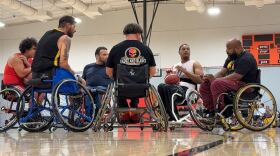Maureen Cavanaugh: Backers of Prop 46 say that the measure is designed to improve patient safety in California, but opponents say it’s really about putting more money in trial attorneys’ pockets. KPBS’ health reporter, Kenny Goldberg, says: “A fight over Prop 46 is proving to be one of the most expensive ones in this fall’s election.” Kenny Goldberg: In 1998, former San Diego Deputy Mayor, Bill Mitchell says he was a victim of medical malpractice. He was diagnosed with glaucoma in his left eye and underwent laser surgery to ease the pressure. The doctors sent him home with a list of four warning signs to look out for. Two weeks later, Mitchell had pain in his left eye Bill Mitchell: So I ran to the mirror and I noticed it was red and a discharge, and I was loosing my vision. Kenny Goldberg: These were the warning signs Mitchell was told about. They indicated a medical emergency. Mitchell immediately called his surgeon, but it wasn’t until later that afternoon that he actually saw him. Bill Mitchell: When he took one look at me, he hurried and took me over to the recna department, and they inserted eighteen shots of antibiotic into my eyeball. Kenny Goldberg: Mitchell was left legally blinded in his left eye. He went to 16 different attorneys to try to find someone to handle what he thought was a strong malpractice claim. But Mitchell says, “because of California’s $250,000 cap on pain and suffering, damages and malpractice suits no one would take the case. Bill Mitchell: When you start talking penny-ante money, where they’d get half of $250,000 that means that $125,000, that is not worth their time. Kenny Goldberg: The California Legislature approved the cap on pain and suffering damages in 1975, in an attempt to lower the price on malpractice insurance. Prop 46 would raise the cap to $1.1 million and index it to inflation. The measure would require random drug testing of doctors and it would mandate physicians who prescribe narcotics to use CURE System, that’s a state wide database that can indicate whether a patient is doctor shopping for dangerous drugs. Proponents say that Prop 46’s three elements would enhance patient safety. But it’s the idea that raising the cap on malpractice awards that’s drawing most of the attention. Speaker 1: The real story behind, start with the trial lawyers. They wrote and paid for Prop 46. Why? Pretty simple, to make millions from medical law suits and higher jury awards. Kenny Goldberg: Dr. Robert Wailes is a specialist in pain medicine and is former president of the San Diego County Medical Society. He’s a starch opponent of Prop 46. In fact, he’s put on “No on Prop 46” signs all over his Encenitas office. Dr, Robert Wailes says, “lifting the cap will drive up the cost of malpractice insurance.” Dr. Robert Wailes: That cost is going to be passes on to all of us. It increases the cost of healthcare. Kenny Goldberg: Wailes says, “If malpractice insurance rates go up dramatically, some doctors will be forced to close their doors.” Dr. Robert Wailes: So, access to care will be a real issue because of this. And, we don’t want to decrease access to care in a time like this when we are trying to expand access to care. Kenny Goldberg: Carmen Balber is executive director of the non-profit Consumer Watch Dog. Her group is the driving force behind Prop 46. She says, “’No Prop 46 Campain’ is funded primarily by malpractice insurance companies.” Collectively, opponents have raised $56 million to defeat the initiative. In contrast, supporters have amassed about $7 million. Balber says, “Arguments against the measure are just scare tactics.” Carmen Balber: The last thing the insurance industry wants to do is play a fair game and say, “Well, what really don’t want to do is allow a few more families to go to court and hold dangerous doctors accountable.” Kenny Goldberg: Balber says, “Changing the nearly 40 year old cap on pain and suffering awards is central to Prop 46.” Carmen Balber: But the other pieces are too and that is because deterring substance abuse, whether it’s by physicians or patients, and deterring medical negligence is going to save lives across the board. Kenny Goldberg: A study in the Journal of Patient Safety estimates more than 400,000 Americans die each year as a result of medical mistakes. A field poll in early July showed 58% of likely voters were in favor for Prop 46. That support dropped by nearly 34% by early September. Kenny Goldberg, KPBS News.
Backers of Proposition 46 on the November ballot say the measure is designed to improve patient safety in California.
Proposition 46: The Basics
Proposition 46 would raise the cap on medical malpractice awards from the current $250,000 to more than $1 million.
It would require drug and alcohol testing of doctors and mandate reporting to the California Medical Board. If a doctor is found to be impaired while on duty it would require the doctor to be disciplined.
It would require health care providers to consult the California controlled substances database, CURES, to ensure patients aren't doctor shopping for unneeded prescription drugs.
But opponents say Proposition 46 is really about putting more money into trial attorneys’ pockets.
While the measure has three components, the one that would lift the cap on awards for medical malpractice is garnering most of the attention.
Bill Mitchell's Story
One San Diegan who believes it is time to lift the cap on medical malpractice is Bill Mitchell.
Mitchell, a former San Diego Deputy Mayor, says he was the victim of medical malpractice in 1998.
He was diagnosed with glaucoma in his left eye, and underwent laser surgery to ease the pressure. The doctor sent him home with a list of four warning signs to look out for.
Two weeks later, Mitchell had pain in his left eye.
“So I ran to the mirror, and I noticed it was red, and a discharge, and I was losing my vision," Mitchell recalled.
These were the warning signs indicating a medical emergency, Mitchell had been warned. He immediately called his surgeon, but it wasn’t until later that afternoon that he actually got an appointment.
“When he took one look at me, he hurriedly took me over to the retina department, and they inserted 18 shots of antibiotic into my eyeball,” Mitchell said.
But Mitchell was left legally blind in his left eye. He went to 16 different attorneys to try to find someone to handle what he felt was a strong malpractice claim.
But, Mitchell said, because of California’s $250,000 cap on pain and suffering damages in malpractice suits, no one would take the case.
“When you start talking penny-ante money, where they’d get half of the $250,000, that means $125,000, that isn’t worth their time,” Mitchell said.
The California Legislature approved the cap on pain and suffering damages in 1975, in an attempt to lower the price of malpractice insurance.
Proponents say Proposition 46’s three elements would all enhance patient safety.
What Do Opponents Say?
But opponents disagree. They argue the CURES system can't handle the current number of requests, let alone an increased number of inquiries. And they maintain altering the cap on pain and suffering damages would be catastrophic.
That argument is the focus of many of the 'No on Prop. 46' television ads.
“The real story behind Proposition 46? Start with the trial lawyers," begins one of the advertisements. "They wrote and paid for Prop. 46. Why? Pretty simple. To make millions from medical lawsuits and higher jury awards.”

Dr. Robert Wailes is a specialist in pain medicine and former president of the San Diego County Medical Society. He’s a staunch opponent of Proposition 46. In fact, he’s put 'No on 46' signs all over his Encinitas office.
Dr. Wailes said lifting the cap will drive up the cost of malpractice insurance.
“That cost is going to be passed onto all of us. It increases the cost for health care,” he said.
Wailes explained that if malpractice insurance rates go up dramatically, some doctors will be forced to close their doors.
“So access to care will be a real issue because of this," Wailes said. "And we don’t want to decrease access to care at a time like this, when we’re trying to expand access to care."
But malpractice insurance rates are regulated in California. The state insurance commissioner has the authority to reject premium increases found to be excessive.
What Do Supporters Say?
Amitabh Chandra, a health economist at Harvard University, said changes to the cap wouldn't necessarily lead to higher overall healthcare costs.
"If you look at states that don’t have the cap compared to states that do have the cap, you don’t really see these big variations in malpractice insurance premiums," Chandra said. "Nor do you see variation in, say, the use of medical care.”

Carmen Balber, executive director of the nonprofit Consumer Watchdog, said opponents' doomsday forecasts are misleading. Her group is the driving force behind Proposition 46.
Baber said the 'No on 46' campaign is funded primarily by malpractice insurance companies. She said arguments against the measure are scare tactics.
“The last thing the insurance industry wants to do is play a fair game and say, 'Well, what we really don’t want to do is allow a few more families to court and hold dangerous doctors accountable,'" Balber said.
She explained that changing the nearly 40-year-old cap on pain and suffering awards is central to Proposition 46, but the other components are important too.
"Deterring substance abuse, whether it’s by physicians or patients, and deterring medical negligence, is going to save lives across the board,” she said.
A study in the Journal of Patient Safety estimates more than 400,000 Americans die each year as the result of medical mistakes.
Follow the Money
Collectively, opponents of Proposition 46 have raised more than $56 million to defeat the initiative.
In contrast, supporters have amassed about $7 million.
A Field Poll in early July showed 58 percent of likely voters were in favor of Proposition 46.
That support had dropped to 34 percent by early September.
Related: KPBS' full election coverage and voters guide






